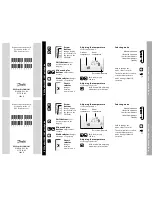
19
9. Troubleshooting
If any malfunctions occur, refer to the following items after checking the power supply to the controller.
9.1
Indication
Problem
Presumed cause and solution
“
” is indicated on the PV
display.
• The controller is in the EXCEEDED indicator lighting duration time
mode.
Press the
key twice to revert to the PV/SV display.
“
” or
“
” is
indicated on the PV display.
• Maximum (Minimum) value is indicated.
Press the
key once to revert to the PV/SV display.
“
” is flashing on the PV
display.
• Burnout of thermocouple, RTD or disconnection of DC voltage (0 to
1V DC)
Change each sensor.
How to check whether the sensor is burnt out
[Thermocouple]
If the input terminals of the instrument are shorted, and if a value
around room temperature is indicated, the instrument is likely to
be operating normally, however, the sensor may be burnt out.
[RTD]
If approx. 100 of resistance is connected to the input terminals
between A-B of the instrument and between B-B is shorted, and
if approximate 0 (32 ) is indicated, the instrument is likely to
be operating normally, however, the sensor may be burnt out.
[DC voltage (0 to 1V DC)]
If the input terminals of the instrument are shorted, and if a scaling
low limit value is indicated, the instrument is likely to be operating
normally, however, the signal wire may be disconnected.
• Check whether the input terminals of thermocouple, RTD or DC voltage
(0 to 1V DC) are securely mounted to the instrument input terminal.
Connect the sensor terminals to the instrument input terminals securely.
“
” is flashing on the PV
display.
• Check whether input signal source for DC voltage (1 to 5V DC) or
DC current (4 to 20mA DC) is disconnected.
How to check whether the input signal wire is disconnected
[DC voltage (1 to 5V DC)]
If the input to the input terminals of the instrument is 1V DC and
if a scaling low limit value is indicated, the instrument is likely to be
operating normally, however, the signal wire may be disconnected.
[DC current (4 to 20mA DC)]
If the input to the input terminals of the instrument is 4mA DC and
if a scaling low limit value is indicated, the instrument is likely to be
operating normally, however, the signal wire may be disconnected.
• Check whether input signal wire for DC voltage (1 to 5V DC) or DC current
(4 to 20mA DC) is securely connected to the instrument input terminals.
• Check if polarity of thermocouple or compensating lead wire is correct.
• Check whether codes (A, B, B) of RTD agree with the instrument terminals.
The indication of PV display is
abnormal or unstable.
• Check whether sensor input or temperature unit ( or ) is correct.
Select the sensor input and temperature unit ( or ) properly.
• Sensor correcting value is unsuitable. Set it to a suitable value.
• Check whether the specification of the sensor is correct.
• AC leaks into the sensor circuit. Use an ungrounded type sensor.
• There may be equipment that interferes with or makes noise near
the controller.
Keep equipment that interferes with or makes noise away from the
controller.


































